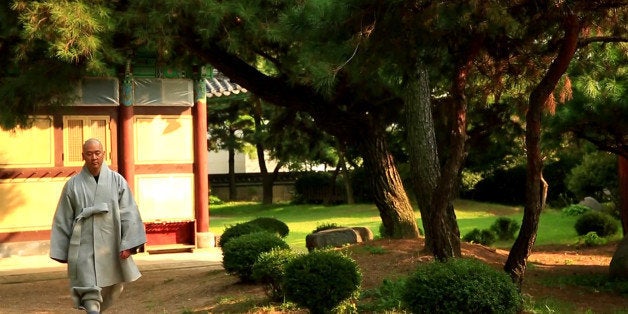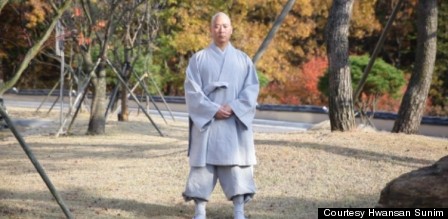
Thus far we've learned how to perform Son Buddhist meditation in several common physical positions ("How to Meditate Sitting in a Chair, Parts 1 and 2," "How to Meditate Standing Up," "How to Meditate Lying Down"). We've also learned how to set up a daily meditation schedule ("How to Set Up a Meditation Practice at Home"). Finally, we worked on incorporating micro-sessions of meditation into the routines of our daily life ("How to Meditate During the Workday"). If we've been diligent in our meditative practice, if the various postures, diaphragmatic breathing technique, and regulation of the Great Doubt through the "Yi-mwot-go?" hwadu have become familiar, then we're ready to go to the next level of Son meditation. This is formally called "Son in the midst of commotion." I simply call it the "active" mode of Son meditation. Active Son meditation means learning how to meditate while in physical motion. Today we'll learn how to meditate while walking.
You already may have heard of so-called "walking meditation." The most well-known version of walking meditation consists of walking very slowly and carefully observing the various components of the mechanical process of walking. For example, practitioners observe in stepping forward the extension of the lead foot, contact of the heel with the ground, transferral of weight to the lead foot as it rolls forward onto the sole to make uniform contact with the ground, and so forth.
What we need to understand in the context of active Son meditation, however, is that when we meditate while walking, it's not a meditation about walking. There is no contemplative study of the physical act of walking.
And it's not slow either.

In a traditional Son Buddhist meditation hall, roughly hour-long sessions of seated meditation are interspersed with 10-minute breaks during which the monks silently walk in a large circle around the room. They are expected to maintain meditative focus even during the break. But all of the windows and doors are opened to bring in fresh air and the meditators are free to go to the bathroom or step into another room to stretch out. The point of this break is not to rest, but to refresh and recharge. Thus, when we walk around the room, the pace is brisk and the atmosphere is energetic. Walking Son meditation, to put it simply, is a wake-up call.
Son meditation is not intended to create a state of laxity. Quite the opposite, Son meditation should induce a state of heightened mental alertness and presence. We're not taking a vacation from reality, but plunging into it with our eyes, heart, and body wide-open. Son meditation may be quiet, but it's immersive and electrifying, a direct, no-holds-barred physical and mental engagement with reality. With the pure perceptual experience of living. The art of Son meditation consists of being able to maintain pinpoint mental concentration without physical tension or emotional agitation. Your mind is a diamond drill, but your heart and body are calm and at peace.
Active Son meditation requires that we maintain this exquisitely delicate psycho-physical balance while moving. So the last thing you want to do is break down a physical movement into its components. Just the opposite, you want your body to glide even as your mind stays gyroscopically still, focused on the "Yi-mwot-go?" hwadu. Let's learn how to do this.
Walking Son Meditation
1. Assume standing meditation posture (Refer to "How to Meditate Standing Up").
2. Remember to hold your left hand in your right hand as shown in the photo and place both hands on your abdomen. The pressure of your hands on your abdomen will help you keep your focus there as you walk.
3. Begin walking slowly while keeping your gaze on the ground ahead.
4. Keep your focus on the "Yi-mwot-go?" hwadu. Imagine that it resides in your dantien, the center of qi energy in your lower abdomen. Keep your attention there with the same urgency you feel in keeping your eye on your infant child as you go about your chores. One part of your attention is always on the "Yi-mwot-go?" in your gut. You may feel a kind of mass, heat, or vibrating resonance there. That's where you keep your attention. If this description makes no intuitive sense to you, that's okay. Simply keep your attention on the contact point between your hands and your abdomen and intone "Yi-mwot-go?" in a calm and clear mental voice as you walk.
5. Don't obsess over keeping your breathing slow. Your rate of breathing will naturally pick up speed as you move. Just make sure you don't move so fast that you start panting.
6. Don't obsess over the in-out motion of your abdomen used in diaphragmatic breathing. Let your breathing occur naturally. Again, simply keep your attention fixed on the interior space of your lower abdomen while intoning "Yi-mwot-go?"
7. Remember to keep your back straight and be aware of tension in your neck and shoulders as you attempt to concentrate. Many people thrust their head forward in the effort to focus. Be careful to avoid this and keep the line of your spine upright and fully extended.
8. When you get used to coordinating the various mental and physical actions of Son meditation with those of walking, try moving a little faster. You can also drop your hands and walk naturally.
Externally, this meditation looks like you're just walking with a solemn expression on your face. But by now you know that internally you're practically conducting a symphony of diverse micro-actions. This is why it's important to gain proficiency in the mechanics of seated, standing, and lying meditation first. The truth is walking Son meditation comprises the first step in learning how to incorporate meditation -- and its benefits -- into the multi-tasking that occupies so much of modern daily life.
Recommendations and Suggestions
1. Learn proper walking technique. There are many good books on this topic as well as helpful videos on sites like Youtube.
2. You want to feel that you're gliding. This means your speed stays relatively constant and you accelerate and decelerate smoothly, gracefully even. Furthermore, you're not bobbing up and down as you walk nor are you swaying from side to side. Your arms and legs move together, left arm swinging forward as your right foot extends forward and vice versa. You move like you're on a railroad track, but your body is relaxed and your gaze steady.
3. I recommend practicing on a treadmill first. This way you're not distracted by passing scenery. The treadmill also keeps your pace and rhythm constant.
4. Alternatively, you can practice by circling the periphery of a large room. Just remember to practice walking in both directions, clockwise and counter-clockwise.
5. If you want to practice outdoors, pick a quiet place with relatively bland surroundings. An empty beach or parking lot or outdoor running track are good.
6. Be prepared for your thoughts to wander. People tend to ruminate while walking. If you're not careful, you can direct an entire movie or plot your career to retirement in your mind as you walk. Remember that you're not "taking a walk." You're walking purposefully, with energy and focused intent.
Walking Son meditation, obviously, is a great way to combine meditation and exercise. When you get good at it, this way of walking, interestingly enough, is helpful for moving quickly through crowded places such as train stations, airports, and department stores. When human traffic is congested and we're in a rush, we tend to get annoyed with the stop-and-go of people in front of us. However, when we meditate and keep our minds focused and present as we walk, we begin to move highly efficiently, weaving our way and slipping through the crowd without bumping into anyone. Somehow we are simultaneously both comfortably aloof from and intensely committed to our physical actions.
This becomes the first proof in our lived experience that meditation actually enhances our work efficiency rather than distracts us from it. It's a remarkable discovery and eliminates the false distinctions between stillness and movement, contemplation and action, passivity and assertiveness, and meditation and work that most beginning meditators unconsciously harbor.
In Son Buddhism, the ancient masters tell us to "walk all day long without ever taking a step." This is interpreted to mean that we walk with purpose and successfully arrive at our destination, but during all of that time our minds are engaged in meditation and we never become distracted by our physical actions or our worries. In other words, we have achieved perfect balance between living in the present moment and getting the results that we need.
Ultimately, we no longer have to feel conflicted between our desire to stop and smell the roses and the incessant demand that modern life places upon us to keep moving forward. As consistent daily practice in the basics of Son meditation -- posture, breathing, and "Yi-mwot-go?" -- improves our meditative skill, we learn to meditate as we perform increasingly complex tasks. We discover that meditation actually enhances our problem-solving ability and creativity. Later, incredibly enough, we can meditate in the present even as we plan, prioritize, and execute for the future. We are no longer overwhelmed by the constant juggling of tasks. Instead, just as we have learned to orchestrate the actions of our own inner mind and body, so, too, can we now manage the multiple responsibilities of our outer lives. Like a dancer or figure skater whose mind is calm and focused as she performs the most complicated and spectacular choreography, we, too, can learn to be completely present for the full tapestry of events and duties that unfolds for us every day of our lives.
This is not a question of being spiritual enough. It's an issue of committing to the mastery of a skill. Son meditation is the art of living.
Palms together,
Hwansan Sunim
You can now submit questions for Hwansan Sunim to answer on the Son meditation TV program, "Hello, This Is Hwansan Sunim." If possible, record your question on an audio or video file and send it in an email to ask.hwansan@gmail.com. (You may also send your question in written form.) Your email submission should contain the following information: 1) Name, 2) Photo file of you, 3) Age, 4) Occupation, and 5) City of residence. The broadcast date of your question will be sent to you. For further information about communicating with Hwansan Sunim, please visit the Facebook page at https://www.facebook.com/seonbuddhism.